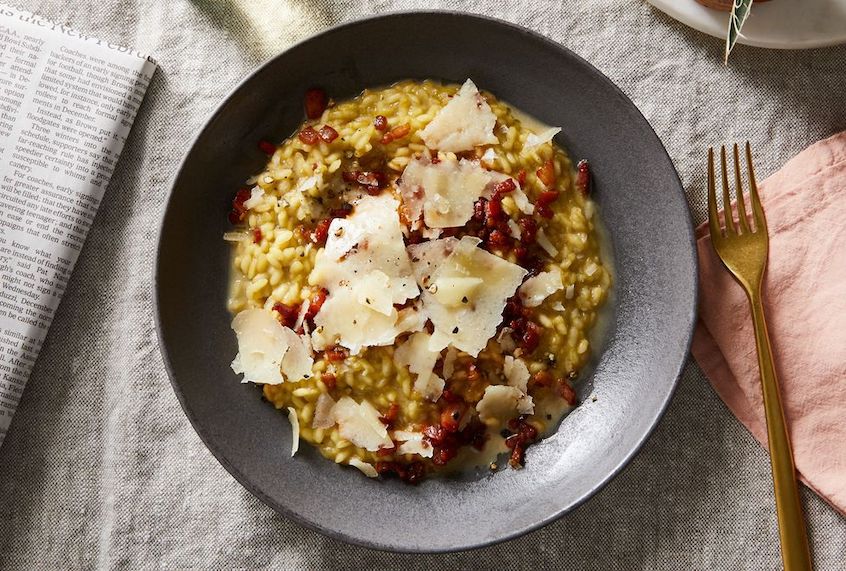“Carbonara must be eaten hot,” Italian cookery writer, Anna Del Conte, writes in her memoir, “Risotto With Nettles.”
I love food like this, the kind you have to serve the minute it comes off the heat. It means you basically have the permission to eat it straight out of the pan (which I often do, as I live alone and there’s no one around to judge me but my dog).
I love the story of carbonara, too. As Del Conte says in her compendious “Gastronomy of Italy,” the dish “gained international fame through the soldiers of the Allied armies, who brought it back from Rome to their native countries after the end of the Second World War. They found in the sauce the familiar foods of their homeland, eggs and bacon, successfully combined with their new love, spaghetti.”
At the end of the day, pasta alla carbonara — which an Italian chef once told me must be made with Pecorino Romano, eggs (mostly yolks), guanciale (cured pork jowl or cheek), and absolutely no cream — is comfort cooking as well as comfort food. You fry up the pork, toss al dente spaghetti into it, and, off the heat, stir in the eggs, cheese, a little starchy pasta water, and lots of freshly ground black pepper.
There’s something comforting, too, about interpreting the starch in carbonara as rice instead of pasta. Because what makes the Roman dish so magical is the way in which the starchiness from the pasta water, thickened up by egg yolks and cheese, is all you need to coat the noodles. Similarly, a thick short-grain rice like Arborio, or even a medium variety like Carnaroli, has that natural starchiness which lends itself amazingly to carbonara.
Don’t get me wrong — I adore spaghetti alla carbonara. But until you’ve folded guanciale fat and egg yolk into a soft-set risotto all’onda (“wavy”), you haven’t lived.
It makes sense that the classic combo of creamy eggs and smoky guanciale would work well in a risotto. Like with carbonara, the egg yolk here doesn’t get cooked directly, but rather vigorously stirred in — off the heat — so it just sets and lends that iconic velvety texture to the rice. But unlike carbonara, a couple other players join the party: a little butter, shallot, and wine (I use vermouth, but a dry white works too) to get the rice started; chicken broth to cook the grains; and cream.
Carbonara purists may chastise me for adding a blush of heavy cream at the end to loosen the risotto so it has that traditional “wave” — but hey, I’ve already strayed from the classic by replacing the pasta, right? The cream, anyway, helps you achieve that texture that makes risotto so luxurious to eat, especially on an ordinary weeknight at home.
But the one thing I will agree on with the purists: Carbonara must be eaten hot.
Prep time: 5 minutes
Cook time: 25 minutes
Serves: 1
Ingredients
- 2 ounces guanciale, diced (bacon or pancetta would work, too)
- 1 teaspoon olive oil
- 1 small shallot, finely diced (about 1/4 cup)
- 1/3 cup Arborio rice
- 1/4 cup dry vermouth or white wine
- 1 1/2 to 1 3/4 cups chicken broth (especially Better Than Bouillon), kept hot in a separate saucepan over low heat
- 1 egg yolk
- 1 tablespoon heavy cream
- Freshly ground black pepper, to taste
- Finely grated Pecorino Romano, to taste, plus shavings for garnish
Directions
- Starting from a cold pan, heat the guanciale in the olive oil until it has crisped up significantly and rendered down much of its fat, about 5 minutes. Remove with a slotted spoon and set aside for later. Pour out the fat, reserving 1 tablespoon in the pan. Sauté the shallot in the guanciale fat for a minute, then add the rice and do the same. Splash in the wine and reduce completely.
- Slowly stir in the hot chicken broth, one ladleful at a time, only adding more once the last addition has been fully absorbed by the rice. This should take about 16 minutes. When you’re nearing the end of your broth, taste your rice: Is it al dente? That is, soft on the outside with a tiny bite left in the center of the grain? When it’s at this stage, remove from heat, cover, and let sit to finish cooking while you prepare the egg mixture.
- In a small bowl or ramekin, whisk together the egg yolk, cream, black pepper, and as much cheese as you want (you can add more later) into a pale-yellow emulsion, which should then be folded into the still-warm risotto, loosening it up a bit.
- Plate — never bowl — your risotto. Top with the reserved crispy guanciale, a few large shavings of Pecorino, and a very generous crack of black pepper (which is, allegedly, the “charcoal” in carbonara).


